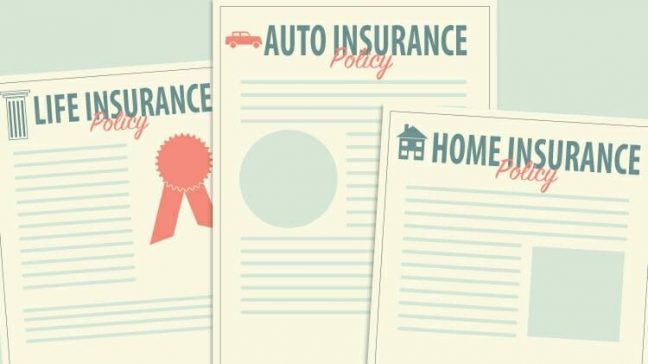There are insurance policies that can cover virtually everything we have and everything we do in life. But how much insurance coverage is enough? And how much might be too much?
There’s no easy answer, but there are general rules of thumb that you can follow. What those rules are will vary depending upon the type of insurance coverage is involved. Here are six categories of personal insurance to consider coverage amounts for.
What’s Ahead:
Life Insurance

When it comes to life insurance, there’s a variety of metrics used to determine how much you will need. And which metrics will be used can depend largely on who’s asking the question.
For example, a life insurance agent – who may be looking to sell you the largest policy possible – may base the death benefit on a multiple of your annual income. He or she may say that you need a policy that is equal to 10 or 20 times your annual income. The theory here is that you will need an amount of life insurance that will replace your income completely for a specified number of years. This may be defined by the number of years that will take for your youngest child to finish college, or for your spouse to retire.
You can also use very specific financial objectives. For example, you can tie the amount of life insurance to the amount of debt that you and your spouse owe. If this includes your mortgage, student loans, car loans, and credit cards, it could result in a very large reduction in the family’s monthly expenses, which will come close to replacing your income.
Use this simple life insurance calculator to decide how much insurance you really need.
Regardless of how much you need, the good news is that term life insurance is very inexpensive, especially when you’re young.
Related: How To Get the Best Price on Term Life Insurance
Health Insurance
This question is actually no longer relevant since the Affordable Care Act (ACA) effectively removed annual and lifetime limits on benefits from health insurance policies purchased on the health insurance exchanges and provided by employers.
The bigger question in regard to health insurance is how much your out-of-pocket limits will be based on a specific policy. Most people are very familiar with deductibles, but those are not the only expense you need to be concerned with.
Most policies also have an out-of-pocket maximum, which can be more important. This is the combination of the deductible plus coinsurance provision. Coinsurance is your responsibility to contribute toward health care expenses that exceed your deductible. For example, if the plan has a $5,000 deductible, but it also requires that you pay 20% of the expenses that exceed the deductible – up to $10,000 – you will be on the hook for an additional $2,000 ($10,000 * .2).
That means that your total out-of-pocket costs will be $7,000 ($5,000 + $2,000) in any one year.
How can you know if that’s the right amount of coverage? Assuming you can comfortably afford the monthly payment on the health insurance policy, the out-of-pocket maximum is reasonable if you have sufficient liquid reserves to cover the amount. In the example above, if you have at least $7,000 in your emergency fund, the out-of-pocket cost is probably reasonable.
Of course, we all know that health insurance is extremely complex, and “rules of thumb” aren’t always conclusive. But using your ability to cover the out-of-pocket maximum is a useful measure of having the right amount of insurance coverage.
Related: Understand Health Insurance Deductibles, Out-of-Pocket Maximums and Coinsurance
Auto Insurance

The necessary amount of auto insurance that you need is easier to determine. That is at least partially because there are required minimum amounts of coverage in each state. Those requirements determine the least amount of coverage that you should have.
Auto insurance coverage amounts are usually expressed by a sequence of three numbers. For example, the state minimum requirement of 50/100/25 means that you are required to have a minimum of $50,000 in coverage for each person injured in an accident (bodily injury), up to a maximum of $100,000 per accident (two people), and $25,000 coverage for property damage.
From a standpoint of legal compliance, you are covered if you meet your state-mandated minimum amounts. And that is a sufficient amount of coverage if you are young and have little or no assets.
On the other hand, if you have home equity and/or investments worth more than your state’s minimum required liability amounts, you want to increase your coverage. One of the major purposes of any type of insurance is to protect your assets. In the case of auto insurance, you should have sufficient coverage to protect your assets if you are sued as a result of an accident where you were at fault.
The more coverage that you have, the less likely it is that a plaintiff will go after your personal assets. If possible, you should want your coverage to be equivalent to your personal assets.
Finally, keep in mind that comprehensive and collision insurance are optional. If you have an older car that’s not worth much, you can knock a bit off your car insurance bill by removing some coverage, but then you won’t be reimbursed if your car is totaled or stolen.
Related: What Type of Car Insurance Do You Need?
Homeowners Insurance
There are a lot of factors that go into a homeowners insurance policy, and determining how much coverage you need is a highly mathematical process. It will also be based on the specific numbers associated with your property and with its contents.
To begin with, you have to insure the physical structure of the property. The best way to do this is through a guaranteed replacement cost policy. Under such a policy, the insurance company will pay the full cost to rebuild your home in the case of a total loss. This will require that you get an accurate estimate of what it costs to replace the home, in order to determine how much coverage you will need. This can be very different from the property’s appraised value. For example, replacement cost does not include the value of the land, since that cannot be replaced.
Your homeowners insurance policy should also include contents coverage. This will include everything is inside your home that is not affixed to the physical structure of the home. You can do a detailed inventory of the contents of your home, but more commonly the insurance company will assign an estimated value, generally 50% or more of the replacement cost of the home, to cover the contents.
If the guaranteed replacement cost of your home is $300,000, $150,000 would be added to cover the contents of the home.
You should also want your coverage to include homeowner’s liability. This is coverage that will protect you in the event that someone is injured on your property and brings a lawsuit against you. Coverage of between $300,000 and $500,000 will likely cover most events that are likely to happen (but hopefully never will!).
Finally, your homeowners insurance policy should include a provision that adjusts coverage levels based on inflation. After all, not only do property values tend to rise over time, but so do the costs of materials and labor that are required to rebuild the home.
Lemonade is a great, up-and-coming insurance company that offers renters and homeowners insurance starting at just $5 for renters and $25 for homeowners. You can get a quote for Lemonade renters insurance by answering a few questions from the company’s friendly chatbot, AI Maya, and Lemonade makes it easy to customize your policy based on the coverage you need.
Related: What Does Homeowners Insurance Actually Cover? (And What Doesn’t It?)
Renters Insurance

Renters insurance covers your property in the event it is damaged or stolen. (Many people don’t realize that if your apartment were to burn down, your landlord’s insurance won’t cover your stuff!) Renters insurance is so cheap, everyone should have it.
Renters insurance is less complicated than homeowners insurance because your only concern is with the contents of your home. You don’t have to worry about four walls, the exterior of the building, or anything else that has to do with the physical structure of the property. That means that you need a lot less renters insurance than if you are a homeowner and need homeowners insurance.
You can do a rough estimate of how much insurance you will need, simply by using a per room estimate and then making adjustments for certain high-cost items. For example, if you live in a six-room home, you can assign $5,000 per room, for a total of $30,000, but then add extra to cover jewelry, computers, personal heirlooms, and the like.
It can be easy to go a little bit high on renters insurance because it’s relatively inexpensive. But just keep in mind that you have to have an inventory – complete with photos – of everything you’re insuring, in order to have a claim fully paid.
Related: What Does Renters Insurance Cover and Why Do You Need It?
Pet Insurance
Pet insurance works similarly to health insurance for humans. It is generally limited to dogs and cats, probably because they are by far the most common pets, and the medical field is quite advanced in treating them.
Health care for pets is generally not nearly as expensive as it is for people, but that doesn’t mean it’s cheap. Major surgery can cost several thousand dollars and could prove to be a significant financial burden.
Determining how much insurance you should have is highly subjective since people have different levels of attachment to their pets. But one thing is certain – if you do have insurance your treatment options will expand. That’s because the insurance will enable you to have procedures and treatments for your pet that you might not consider otherwise.
Lemonade has expanded into the pet insurance niche and offers affordable, adjustable insurance for your furry friends. You can decide on coverage limits ranging from $5,000 to $100,000, and can decide on reimbursement rates and deductibles that satisfy your pet’s needs and your wallet. With Lemonade, you’ll get coverage for a long list of procedures and exams, including wellness exams, vaccines, heartworm testing, bloodwork, and fecal testing. Plus, Lemonade has you covered if your pet experiences any accidents or illnesses. So any sudden surgery, x-rays, labwork, or medications that are needed will also be covered. Plans start at just $10/month – and you’re eligible for a 10% discount if you also insure your home with Lemonade.
Pumpkin, another option for pet insurance, makes pet care more affordable with its dual offering of a pet accident and illness plan and its Pumpkin Preventive Essentials plan. Their optional preventive plan pays for an annual wellness exam and vaccines. That alone will cover many pets’ annual medical needs.
Embrace offers “nose to tail” coverage of any amount, with deductibles ranging from $100 to $1,000. The best thing about Embrace is you choose the coverage levels you want, allowing you to save money by only purchasing as much insurance as you think you’ll need. Embrace also covers exam fees at no additional cost.
Pumpkin Advertiser Disclosure: Pumpkin Pet Insurance policies do not cover pre-existing conditions. Waiting periods, annual deductible, co-insurance, benefit limits and exclusions may apply. For full terms, visit pumpkin.care/insurancepolicy. Products, discounts, and rates may vary and are subject to change. Pumpkin Insurance Services Inc. ("Pumpkin") (NPN #19084749) is a licensed insurance agency, not an insurer. Insurance is underwritten by United States Fire Insurance Company (NAIC #21113, Morristown, NJ), a Crum & Forster Company and produced by Pumpkin. Pumpkin Preventive Essentials is not an insurance policy. It is offered as an optional add-on non-insurance benefit. Pumpkin is responsible for the product and administration. Pumpkin Preventive Essentials is not available in all states. For full terms, visit pumpkin.care/customeragreement.

